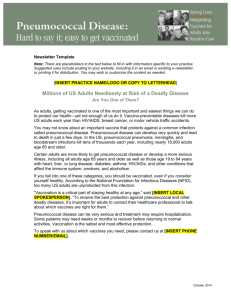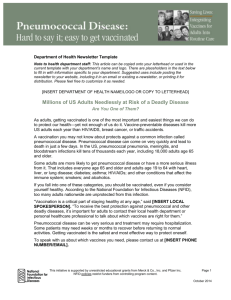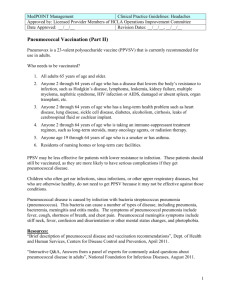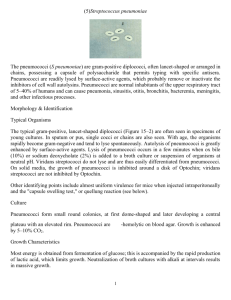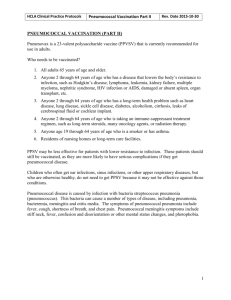File - Dr.Taghreed Khudhur
advertisement
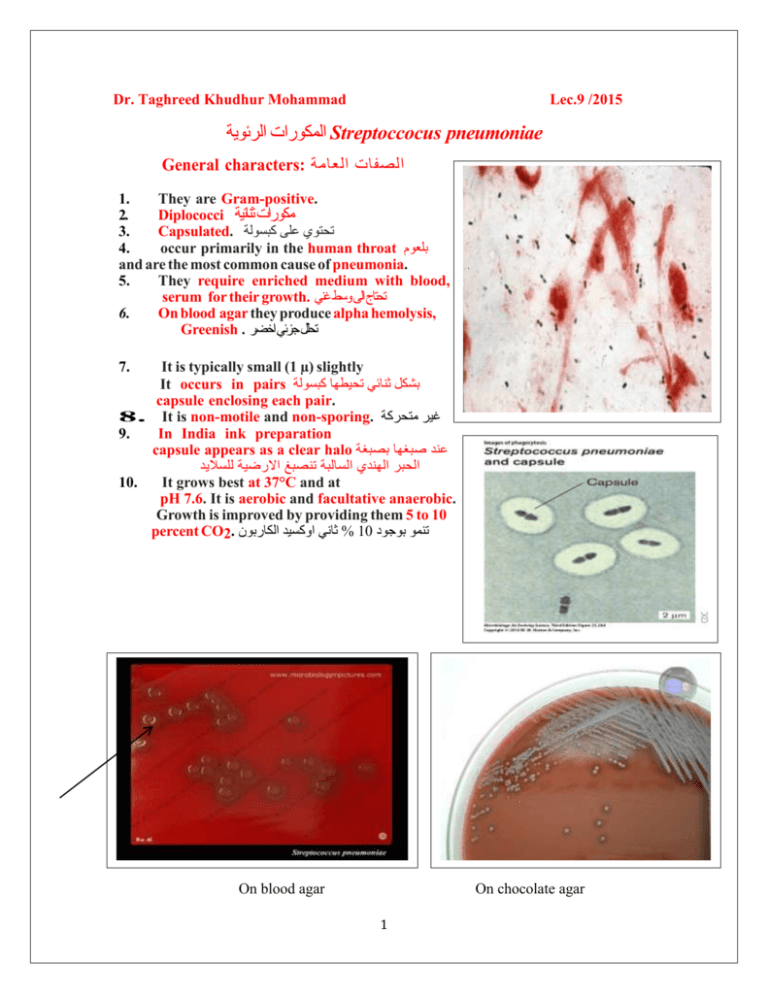
Dr. Taghreed Khudhur Mohammad Lec.9 /2015 المكورات الرئويةStreptoccocus pneumoniae General characters: الصفات العامة 1. They are Gram-positive. 2. Diplococci مكورات ثنائية 3. Capsulated. تحتوي على كبسولة 4. occur primarily in the human throat بلعوم and are the most common cause of pneumonia. 5. They require enriched medium with blood, serum for their growth. تحتاج الى وسط غني 6. On blood agar they produce alpha hemolysis, Greenish . تحلل جزئي اخضر It is typically small (1 µ) slightly It occurs in pairs بشكل ثنائي تحيطها كبسولة capsule enclosing each pair. 8. It is non-motile and non-sporing. غير متحركة 9. In India ink preparation capsule appears as a clear halo عند صبغها بصبغة الحبر الهندي السالبة تنصبغ االرضية للساليد 10. It grows best at 37°C and at pH 7.6. It is aerobic and facultative anaerobic. Growth is improved by providing them 5 to 10 percent CO2. ثاني اوكسيد الكاربون% 01 تنمو بوجود 7. On blood agar On chocolate agar 1 11. Biochemical reaction: It ferments many sugars forming acid only. Inulin is fermented by all pneumococci. They are bile soluble (+) (few drops of 10 percent sodium desoxycholate solution are added to 1 ml of overnight broth culture. 12.catalase negative . 13. oxidase negative. 14.It is sensitive to optochin (ethyl hydrocuprein) in 1/80,000 and it is useful in differentiating them from streptococci. Antigenic structures: a. Nucleoprotein: It is neither species specific nor type specific. Antibody to this antigen is not protective. b. Species specific polysaccharides hapten: It is situated at the cell surface and is not related with capsular antigen. c. Capsular polysaccharide is found in capsulated form. It determines type specificity of organism and virulence. Pneumococci isolated from lobar pneumonia are classfied into 4 types: I, II, III and heterogenous group IV. Members of group IV are further classified into various types. Now about 90 types are known named 1, 2, 3, etc. Typing may be carried out by: 1. Agglutination of cocci with type specific antiserum. 2. Precipitation of capsular polysaccharides with specific serum. 3. Capsular swelling reaction (Quellung reaction): Here suspension of pneumococci is mixed with type specific antiserum. In presence of homologous antiserum the capsule becomes apparently swollen, elineated and refractile. 2 Toxin and Other Virulence Factors 1. Hemolysin: Pneumococcus produces soluble hemolysin in young culture. It gives characteristic green coloration around colonies. تنتج سم محلل للدم 2. It is oxygen labile and its role in the pathogenesis of pneumococcal infection is not known. 3. Capsular polysaccharide: It is specific soluble substance which protects the organism from phagocytosis. It is acidic and has hydrophilic properties. Hence this substance has association with virulence. 4. Pneumococci produce large amount of enzyme resembling receptor destroying enzyme of influenza virus تنتج كميات كبيرة من االنزيمات تمثل كمستقبل محطم. النزيمات فايروس االنفلونزا 5. Leucocidin: It kills leukocytes. سم قاتل لكريات الدم البيض Pathogenesis: األمراضية Pneumococci get attached to nasopharyngeal cell through bacterial surface adhesion (pneumococcal surface antigen-A or choline binding proteins) with epithelial cell receptors. Epithelial binding sites include glycol-conjugates containing the disaccharide GlcHAc1-4 Gal or assialoGM1 glycolipid. Pneumococci produce disease through their ability to multiply in the tissue. They produce no toxins of significance. The virulence of organism is a 3 function of its capsule, which prevents or delays ingestion of encapsulated cells by phagocytes. 1. Pneumococcal infection causes an out pouring of fibrinous edema fluid into alveoli, followed by red cells and leukocytes, which results in consolidation of portion of lung. Many pneumococci are found throughout this exudate. Later mononuclear cells actively phagocytose the debris, and this liquid phase is gradually reabsorbed. The pneumococci are taken up by phagocytes and are digested intracellularly تسبب تليف في سوائل داخل القصيبات بعدها تجمع كريات الدم الحمر والبيض. 2. suppurative infection اصابات قيحيةin various parts of body as Lobar pneumonia في الفص الرئوي: Airborne infection بكتريا تنتشر في الهواءof respiratory tract is a frequent occurrence. The organism is generally eliminated by natural defense mechanism. If resistance is lowered,organism 4 penetrates bronchial mucosa and spreads through lung along peri-bronchial tissue and lymphatics. تخترق الغشاء المخاطي للجهاز التنفسي وتنتشر في الرئة والقصيبات والعقد اللمفاوية 3. Bacteremia is frequent during early stages. وجود البكتريا في الدم 4. Toxemia وجود السم في الدمis due to diffusion of capsular polysaccharide into blood and tissue. The fall of temperature by crisis and relief coincide with complete neutralization of capsular polysaccharide by anti-capsular antibodies. Serotypes 1 to 8, 12 ,41,are mostly the cause of pneumonia. Type 3strain produces particularly severe infection تسبب اصابات قوية. 5. Bronchopneumonia: It is always secondary infection following viral infection of respiratory tract. Bronchopneumonia may be caused by any serotype of pneumococci. رئوي قصبي يحدث بعد االصابة باالنفلونزا كاصابة ثانوية 6. Pneumococcal meningitis السحاياis most serious pneumococcal infection. It occurs when pneumococcal pneumonia is persistant. Disease is common in children . 7. Suppurative lesions like empyema وجود قيح وسوائل, pericarditis التهاب غشاف القلب, otitis media ألتهاب االذن, sinusitis ألتهاب الجيوب االنفية, conjunctivitis ألتهاب القزحيةand peritonitis ألتهاب البريتون. Laboratory Diagnosis التشخيص المختبري Bacteriological tests: Specimens: Sputum, cerebrospinal fluid,pleural fluid, pericardial fluid, peritoneal fluid , ear swab , and pus discharge are collected in a sterile container. 1. Smear examination: Gram staining shows flame-shaped cocci arranged in pairs and they are Gram-positive capsulated. 2. Culture: sample is inoculated on blood agar plates and incubated at 37°C under 5 - 10 % (CO2). Growth occurs after overnight incubation. Blood culture: It shows flat, umbonated colonies showing alpha hemolysis. 5 3. The colonies are treated for inulin fermentation. 4. Bile solubility . They are bile soluble (+) (few drops of 10 percent sodium deoxycholate solution are added to 1 ml of overnight broth culture. 5. Optochin sensitivity test to differentiate it from Streptococcus viridans. 6 6. Catalase negative. Catalase is an enzyme, which is produced by microorganisms that live in oxygenated environments to neutralize toxic forms of oxygen metabolites; H2O2. The catalase enzyme neutralizes the bactericidal effects of hydrogen peroxide and protects them. Anaerobes generally lack the catalase enzyme. 7. Oxidase negative: This oxidase enzyme catalyzes the oxidation of cytochrome c. Organisms which contain cytochrome c as part of their respiratory chain are oxidase-positive and turn the reagent blue/purple. The test reagent, N, N, N’, N’-tetramethyl-p-phenylenediamine dihydrochloride acts as an artificial electron acceptor for the enzyme oxidase. The oxidised reagent forms the coloured compound indophenol blue. 7 Immunologic methods: The detection of pneumococcal capsular polysaccharides in sputum and other body fluids by immunologic methods such as counter immunoelectrophoresis or latex agglutination provides an alternative to bacteriologic techniques for presumptive diagnosis of pneumococcal infection. Because of cross-reactions between the polysaccharides of pneumococci and other bacterial species, immunologic diagnosis is less specific than bacteriologic diagnosis. The Quelling reaction is a biochemical reaction in which antibodies bind to the bacterial capsule of Streptococcus pneumoniae . Animal pathogenecity: Mice are most susceptible to pneumococcal infection (except type 14). It is used for rapid diagnosis. Sputum is emulsified with saline. One ml is inoculated intraperitoneally into 2 mice. Animal usually dies within 24 hours. The encapsulated diplococci can be demonstrated in heart blood and peritoneal fluid. Treatment: Sulfonamides and penicillins are quite effective drugs. Resistance may develop with antibiotics like sulfonamides and tetracycline. Rarely penicillin resistant strains of pneumococci do occur. 8 Q- Compare between Streptococcus pneumoniae and Streptocccus viridanse ? 9
